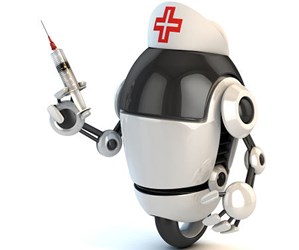Robots Help Deliver Quality Care

By Christine Kern, contributing writer

A fleet of 25 robotic workers are providing cutting-edge communications technology and helping to bolster patient care.
UCSF Medical Center has opened what some think is a hospital from the future, employing a fleet of 25 robotic workers and implementing cutting-edge technology to deliver quality patient care to improve outcomes and cost efficiency.
The fleet of Aethon “Tug” robots, which make up the largest fleet of free-roaming hospital robots in the world, will carry out basic tasks previously performed by human counterparts in an effort to reduce workplace injuries among hospital staff and allow medical staff to focus on providing medical care, according to Computer World. Some 160 other hospitals currently employ robots for some medical tasks, CNET reports.
The new fleet was unveiled at a press conference where Dr. Seth Bokser, UCSF Medical Center’s clinical informaticist and Medical Director of IT explained, “Our neighbors in San Francisco and Silicon Valley have shown us how information technology can empower people in so many areas of their day-to-day lives. At UCSF Mission Bay, we have partnered with local and international innovators to build leading-edge, patient-facing technology that empowers our families for their health.
“We want to use technology in a way that frees up our human providers to do what they’re good at, which is to focus on our patients,” he told The San Francisco Chronicle. “Patient-centered care is not just about putting technology into a hospital.”
The robots work largely around the clock and can open doors, call elevators, and roam around the hospital by themselves, only requiring human intervention if they encounter obstacles. On any given day, UCSF Medical Center's computer simulations estimate that a Tug robot will traverse 12 miles, or about 300 miles a day across the entire fleet. The robots carry out both scheduled and on-demand tasks such as delivering meals to patients, picking up their dirty trays, and delivering medicine or running specimens to the lab.
“Tissue samples, blood samples need to get from point A to point B very fast. You can't afford to wait for someone to show up,” Ken Goldberg, professor of robotics at University of California at Berkeley told CNET. “The robot that never gets distracted, never stops for coffee, could be great for these critical deliveries.”
Josh Adler, chief medical officer of UCSF Medical Center, told CNET the robots are “so much more reliable for delivering things where they need to be on time. That allows our staff to focus on things that people do so well – caring, decision-making, supporting.”
In addition to the robotic fleet, UCSF Medical Center at Mission Bay has implemented cutting-edge technology ranging from interactive wall installations to wireless communication devices for the staff. Patient rooms will have a “media wall,” a 60-inch flat-screen TV that lets people order room service, send emails, use Skype, and watch movies. Doctors can also use the media walls to call up scans and x-rays to show patients. Patients and staff also have access to tablets that allow them to communicate with care providers, see lab results, or order custom meals and there is also a text, voice, and mobile alarm system for staff use designed by Voalte. Bokser explained, “We’re building ‘health 2.0’ here at UCSF Mission Bay.”
